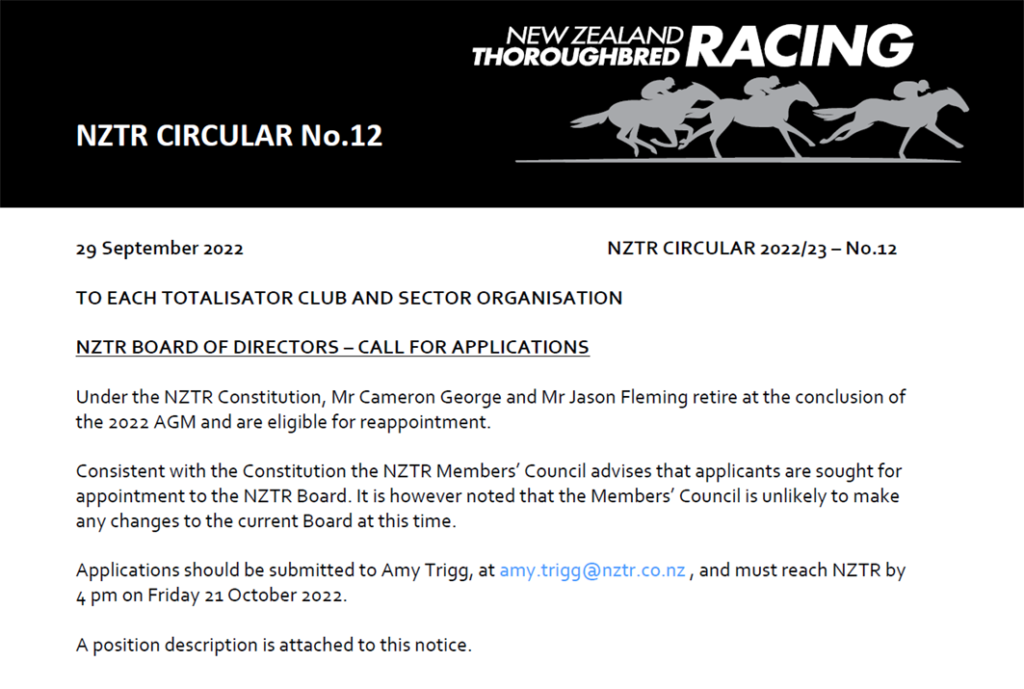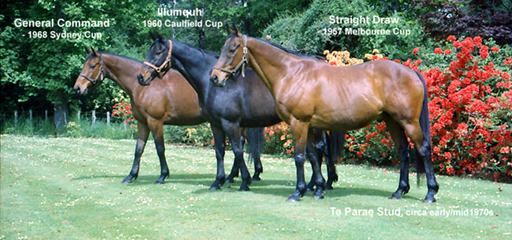Three NZ-bred greats of the past, all bred at Te Parae Stud where they returned for retirement
by Brian de Lore
Published 30th November 2022
The big positive, and one of the very few pluses for New Zealand racing today, is as a nation of horse breeders, the level of success achieved by the country’s breeders in Australia is extraordinary.
The pivotal strength of New Zealand has always come back to the quality of the product; the continued production of horsemen and women who have repeatedly over-achieved during the past 140 years and produced a superior thoroughbred product to race on Australasian racecourses.
The overused and hackneyed expression of ‘boxing above your weight’ has never rung more truthfully than in the production of thoroughbred horses. Aided by a primarily rural population in which a temperate climate helped produce rich grass-growing soils, it resulted in an environment perfect for rearing horses.
Hayes, Smith and Cummings – great NZ supporters
In the 50 post-World War II years, the most successful Australian trainers, such as Colin Hayes, TJ Smith, and Bart Cummings, recognised the Kiwi advantage and never missed coming to New Zealand to secure horses to train like Redcraze, Tulloch, Light Fingers, Galilee, Think Big, Dulcify, Hyperno, Gold and Black, Saintly, So You Think, etc.
Yes, that was then, I hear you say, and it isn’t relevant today. But it is significant because the production of quality NZ-breds has continued to succeed in Australia, albeit on a diminishing foal crop. We have declined to foal numbers equivalent to the spring of 1970, but the number has levelled out over the past two seasons.
Accurate foal crop numbers aren’t available until the Stud Book has received all the broodmare returns, and therein lies the problem. For example, upon checking with the Stud Book this week, I discovered that 138 current yearlings with registered brands do not yet officially exist as foals due to their breeders failing to submit broodmares returns from last season.
It’s an annual, ongoing problem with the same group of recidivist offenders.
Foal crop 45% of its former self
New Zealand today produces only 45 percent of the record foal crop number of 6,112 in 1986 from 11,136 mares bred in 1985. Australia has also lost ground in numbers, represented today by 65 percent of its 1985 numbers, but it’s pertinent to say the Australian industry is much stronger today than in 1985.
Around that time, John Messara working closely with Colin Hayes and a very supportive Prime Minister in Bob Hawke, wrote the submissions and lobbied the Australian Government on behalf of the breeding industry to get parity with New Zealand’s tax write-offs, and succeeded. The Federal Government approved it in 1987 and opened the door for a massive investment in the Australian breeding industry and for Messara’s Arrowfield Stud to acquire and shuttle the great Danehill.
New Zealand racing received an uppercut with the introduction of GST in 1986 (instant 10% inflation), and in the 1987 post-sharemarket crash wash-up; the greedy became the needy after the exposure of the tax-evading special partnerships
Back to the present, New Zealand breeders should receive applause in the current season. Despite losing their best fillies and mares annually to overseas buyers, they have rallied and enjoyed a successful string of results in Australia through this highly talented bunch:
Roch ‘n’ Horse and others
Lost And Running, No Compromise, High Emocean, I Wish I Win, Roch ‘n’ Horse, Gypsy Goddess, Riodini, Smokin’ Romans, Callsign Mav, Icebath, Aegon, Renaissance Woman, I’m Thunderstruck, Mo’unga, Sharp ‘n’ Smart, She’s Licketysplit, Mr Brightside, and Hezashocker. Who did I forget?
The breeding industry has done brilliantly with its limited resources. The rest of the industry has performed relatively poorly, with a cumbersome and costly administrative structure that oversees an ever-increasing string of abandonments in an industry clearly in decline.
We have boards for TAB NZ, Racing New Zealand, Racing Integrity, Members’ Council, and one each for thoroughbreds, harness, and greyhounds. Every year the collective cost of running these boards grows at an alarming rate while the collective racing industry diminishes with its ageing and dying demographic with no succession plan.
Seven boards that collectively fail as an administrative umbrella because they are thin on knowledge, passion and vision. Inducting a brilliant lawyer, accountant or business strategy analyst onto any of these boards is a waste of time if the inductee is unfamiliar with the industry. All those people do is collect the director’s fees, and contribute nothing but assumingly have an excellent social time – and we keep bringing them in.
The board ate lunch and left…
Consider this: An NZTR board meeting was held at Riccarton racecourse this season on one of the biggest days of the year. They concluded their board meeting, had a free lunch in the Balmerino Room, and all left for home after lunch bar the Otago representative – before the feature race was run – that’s their level of commitment.
Just think about this: the most successful administration era in racing came post-WW II when racing saw four decades of sustained growth with the best people in the industry stepping up and giving their time pro-bono – passionate insiders that did it for free. Now we have a members’ council drawn from people in the industry who wouldn’t know a good director if one hit them in the face, so they ask for trouble by advertising to the Institute of Directors.
Here’s a typical example of the lack of democracy conducted by NZTR when they sent out a call for applications for directors on 29 September.

The middle paragraph clearly states: “It is however noted that the Members’ Council is unlikely to make any changes to the current Board at this time.”
Cronyism
That’s what happens when the incumbent board builds a wall around themselves, and cronyism begins. But it didn’t start here; it’s been there for a long time. The Members’ Council is supposed to be independent of NZTR, but clearly, it isn’t and is under the control of NZTR, so why have them at all?
And my information is that today, the board or CEO will inform staff that NZTR will be shifting its office from Petone to Cambridge in 2024. An expanding number of NZTR employees will likely be asked to move north or be made redundant. The cost of salaries at NZTR increased from $4.1 million year ended 2020, to $5.4 million year ended 2021 – doesn’t CEO Bruce Sharrock understand that you have to cut your cloth in these tough times?
Does anyone remember when Trackside shifted from Petone to Auckland? It cost $11 million, and there was no justification for moving except for the convenience of CEO Andrew Brown who was on 900,000 euros annually. How much will it cost to shift to Cambridge, where prices are no different from those of a good suburb in Auckland?
Stud Book in Wellington since 1899
The Stud Book has resided in Wellington since 1899, when Volume One was published. It’s a very specialised job conducted by extraordinary people who often spend their entire working lives dedicated to it – do you think the NZTR board has considered or even cares about that?
Every facet of business conducted by NZTR today can be completed online, so there is no justification for arguing for the industry to be closer geographically to the administrative arm. This move only suits the directors – it’s completely self-serving.
Shifting NZTR to Cambridge will cost a fortune in a financial year when TAB returns to the codes are likely to shrink. This week I learned the TAB had warned NZTR about that likely downturn in revenue, and you only have to look at the August and September monthly results compared to 2021 to realise we might be in for some headwinds.
August profit was down, and although September turnover increased on 2020 by $20.5 million, profit reduced from $13.8 million to $13.2 million. Bonus bets and all the other promotions were the likely cause.
The DIA is currently reviewing the possibility of geo-blocking betting in New Zealand to push all betting through TAB NZ. NZTR CEO Bruce Sharrock and TAB NZ CEO Mike Tod both favour getting it through parliament. They’re deluded if they think that’s the answer.
Restricting Kiwi punters to the monopoly of TAB NZ, which offers a lousy product and skinny odds compared to the corporates operating in Australia, might cure Kiwis from betting at all.
The Aussies have all the choices and enjoy the best options. In NZ, we are starting to resemble the Russians – very few options and losing the war.

